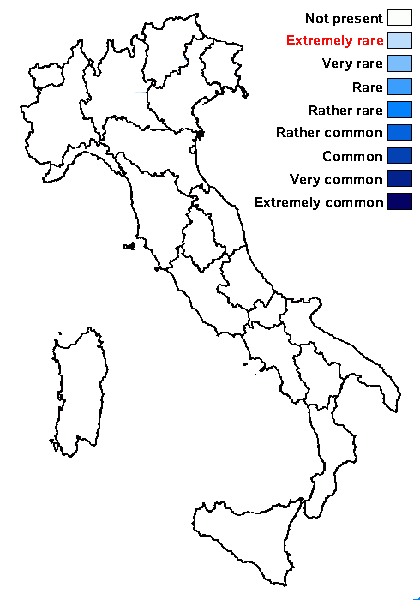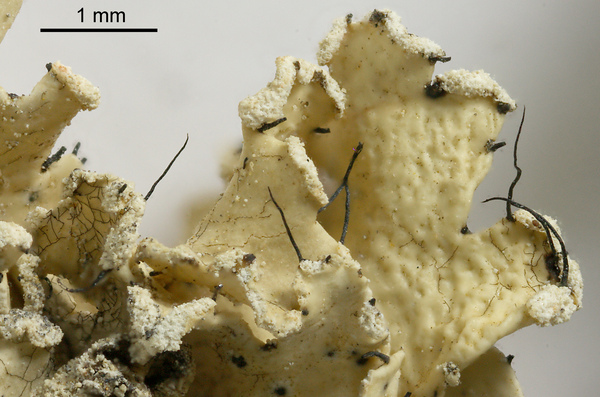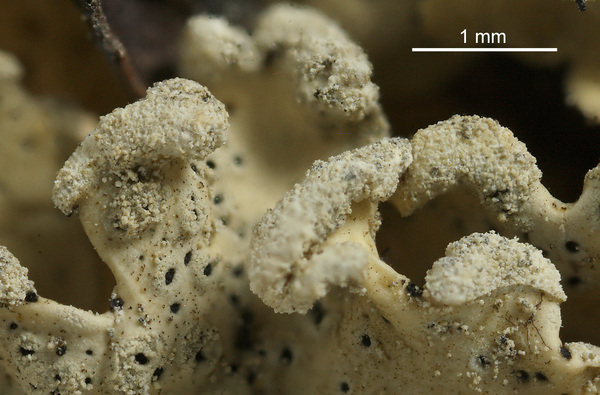Parmotrema hypotropum (Nyl.) Hale
Phytologia, 28, 4: 337, 1974. Basionym: Parmelia hypotropa Nyl. - Syn. Meth. Lich., 1, 2: 378, 1860.
Synonyms:
Distribution:
Description: Thallus foliose, heteromerous, dorsiventral, very loosely attached, rather rigid, sorediate. Lobes irregular, ascending and often forming tufts on small branches, 5-8(-10) mm wide, grey to pale greenish grey with some blackened areas, densely and very finely white-maculate, the margins strongly undulate and often down-turned, with sparse to abundant, up to 2 mm long (but sometimes very short and hardly visible), black cilia. Soralia initially marginal, linear, later sometimes labriform to crescent-shaped, often merging and becoming subcapitate, rarely extending to the upper surface. Lower surface white and erhizinate in peripheral parts, black in central parts, often with a few scattered, simple, black rhizines. Upper cortex of tightly packed, anticlinally oriented hyphae, with a pored epicortex, the cell walls with lichenan intermediate between the Cetraria- and the Xanthoparmelia-types; medulla white; algal layer continuous. Apothecia extremely rare. Photobiont chlorococcoid. Spot tests: upper cortex K+ yellow, C-, KC-, P+ yellow, UV-; medulla K+ yellow turning red (needle-like crystals), C-, KC-, P+ yellow, UV-. Chemistry: upper cortex with atranorin and chloroatranorin; medulla with norstictic acid.Note: a species very similar to P. hypoleucinum, described from Texas. As the only 2 European samples of P. hypoleucinum from the Mediterranean which were molecularly analysed by Widhelm & al. (2016) proved to cluster together with P. hypotropum, the presence of this species is Italy is a possibility, and all Italian material of P. hypoleucinum, a species described from Portugal, urgently needs revision. The two species have a slightly different chemistry (Lendemer & al. 2015), and Italian material identified as P. hypoleucinum is heterogeneous in the development of cilia. I do not exclude that both species do occur in Italy.
Growth form: Foliose, broad lobed
Substrata: bark
Photobiont: green algae other than Trentepohlia
Reproductive strategy: mainly asexual, by soredia, or soredia-like structures (e.g. blastidia)
Most common in areas with a humid-warm climate (e.g. most of Tyrrenian Italy)
Taxon bound to maritime-coastal situations

Predictive model


Felix Schumm - CC BY-SA 4.0
[16779], USA, Mexico, Baja California Sur, along Rte 22, 21 km W of Ciudad Contitución, 24°59’ N, 111°51’ W, 30 m, southern Magdalena Region of the Sonoran Desert, on Jatropha. Leg. T.H. Nash III, 8 Jan. 1989 (Nr. 26,026), det. T.H. Nash III.


Felix Schumm - CC BY-SA 4.0
[16779], USA, Mexico, Baja California Sur, along Rte 22, 21 km W of Ciudad Contitución, 24°59’ N, 111°51’ W, 30 m, southern Magdalena Region of the Sonoran Desert, on Jatropha. Leg. T.H. Nash III, 8 Jan. 1989 (Nr. 26,026), det. T.H. Nash III.


Felix Schumm - CC BY-SA 4.0
[16779], USA, Mexico, Baja California Sur, along Rte 22, 21 km W of Ciudad Contitución, 24°59’ N, 111°51’ W, 30 m, southern Magdalena Region of the Sonoran Desert, on Jatropha. Leg. T.H. Nash III, 8 Jan. 1989 (Nr. 26,026), det. T.H. Nash III.
Growth form: Foliose, broad lobed
Substrata: bark
Photobiont: green algae other than Trentepohlia
Reproductive strategy: mainly asexual, by soredia, or soredia-like structures (e.g. blastidia)
Most common in areas with a humid-warm climate (e.g. most of Tyrrenian Italy)
Taxon bound to maritime-coastal situations

Predictive model


Felix Schumm - CC BY-SA 4.0
[16779], USA, Mexico, Baja California Sur, along Rte 22, 21 km W of Ciudad Contitución, 24°59’ N, 111°51’ W, 30 m, southern Magdalena Region of the Sonoran Desert, on Jatropha. Leg. T.H. Nash III, 8 Jan. 1989 (Nr. 26,026), det. T.H. Nash III.


Felix Schumm - CC BY-SA 4.0
[16779], USA, Mexico, Baja California Sur, along Rte 22, 21 km W of Ciudad Contitución, 24°59’ N, 111°51’ W, 30 m, southern Magdalena Region of the Sonoran Desert, on Jatropha. Leg. T.H. Nash III, 8 Jan. 1989 (Nr. 26,026), det. T.H. Nash III.





